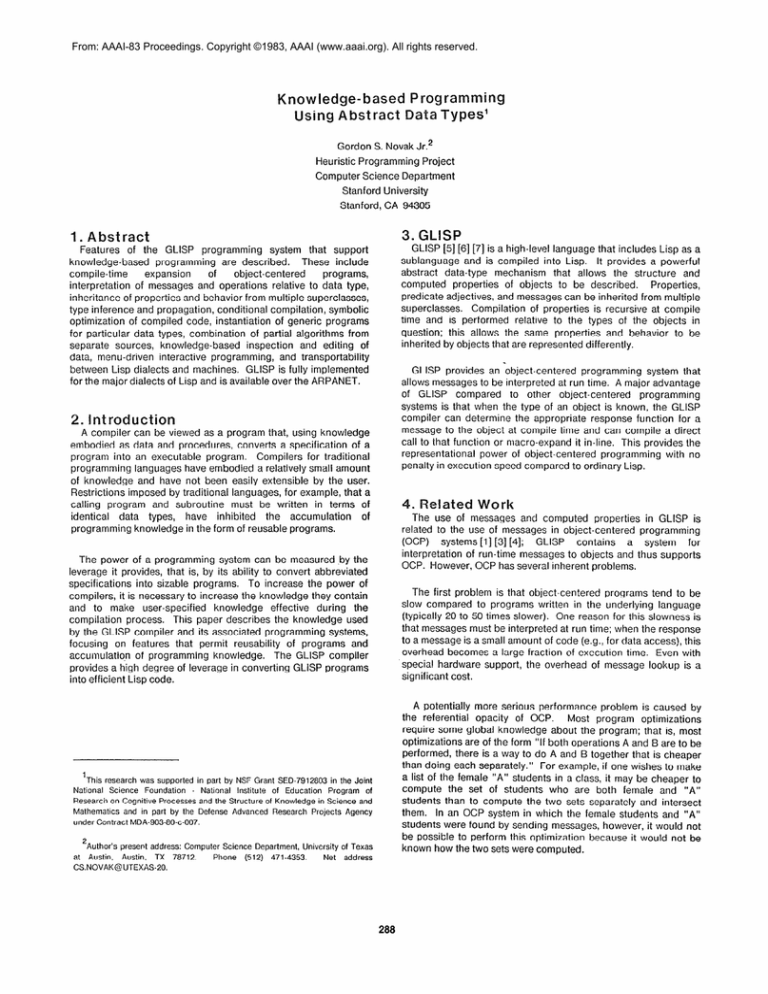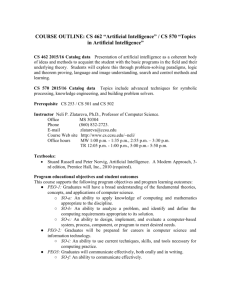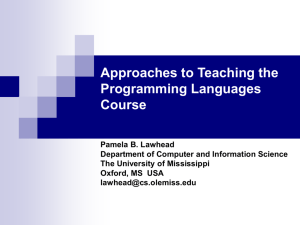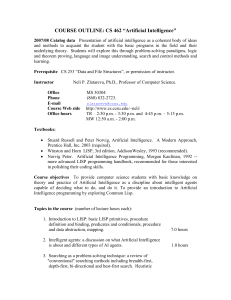
From: AAAI-83 Proceedings. Copyright ©1983, AAAI (www.aaai.org). All rights reserved.
Knowledge-based
Using Abstract
Programming
Qata Types’
Gordon S. Novak Jr.2
Heuristic Programming
Project
Computer Science Department
Stanford University
Stanford, CA 94305
1. Abstract
3. GLISP
Features of the GLISP programming
system that support
knowledge-based
programming are described.
These include
compile-time
expansion
of
object-centered
programs,
interpretation of messages and operations relative to data type,
inheritance of properties and behavior from multiple superclasses,
type inference and propagation, conditional compilation, symbolic
optimization of compiled code, instantiation of generic programs
for particular data types, combination of partial algorithms from
separate sources, knowledge-based
inspection and editing of
data, menu-driven interactive programming, and transportability
between Lisp dialects and machines. GLISP is fully implemented
for the major dialects of Lisp and is available over the ARPANET.
GLISP [5] [6] [7] is a high-level language that includes Lisp as a
sublanguage and is compiled into Lisp. It provides a powerful
abstract data-type mechanism that allows the structure and
computed properties of objects to be described.
Properties,
predicate adjectives, and messages can be inherited from multiple
superclasses.
Compilation of properties is recursive at compile
time and is performed relative to the types of the objects in
question; this allows the same properties and behavio; to be
inherited by objects that are represented differently.
GLISP provides an -object-centered programming system that
allows messages to be interpreted at run time. A major advantage
of GLISP compared
to other object-centered
programming
systems is that when the type of an object is known, the GLISP
compiler can determine the appropriate response function for a
message to the object at compile time and can compile a direct
call to that function or macro-expand it in-line. This brovides the
representational power of object-centered
programming with no
penalty in execution speed compared to ordinary Lisp.
2. Introduction
A compiler can be viewed as a program that, using knowledge
embodied as data and procedures, converts a specification of a
program into an executable program.
Compilers for traditional
programming languages have embodied a relatively small amount
of knowledge and have not been easily extensible by the user.
Restrictions imposed by traditional languages, for example, that a
calling program and subroutine must be written in terms of
identical
data types, have inhibited
the accumulation
of
programming knowledge in the form of reusable programs.
4. Related
The power of a programming system can be measured by the
leverage it provides, that is, by its ability to convert abbreviated
specifications into sizable programs. To increase the power of
compilers, it is necessary to increase the knowledge they contain
and to make user-specified
knowledge
effective during the
compilation process. This paper describes the knowledge used
by the GLISP compiler and its associated programming systems,
focusing on features that permit reusability of programs and
accumulation of programming knowledge.
The GLISP compiler
provides a high degree of leverage in converting GLISP programs
into efficient Lisp code.
‘This research
was supported
National
Science
Research
on Cognitive
under Contract
LAuthor’s
Austin,
in part by NSF Grant SED-7912803
-
Processes
National
Institute
and the Structure
and in part by the Defense
Mathematics
at
Foundation
Advanced
of
Education
of Knowledge
Research
The first problem is that object-centered programs tend to be
slow compared to programs written in the underlying language
(typically 20 to 50 times slower). One reason for this slowness is
that messages must be interpreted at run time; when the response
to a message is a small amount of code (e.g., for data access), this
overhead becomes a large fraction of execution time. Even with
special hardware support, the overhead of message lookup is a
significant cost.
A potentially more serious performance problem is caused bv
the referential opacity of OCP.
Most program optimization;
require some global knowledge about the program; that is, most
optimizations are of the form “If both operations A and B are to be
performed, there is a way to do A and B together that is cheaper
than doing each separately.” For example, if one wishes to make
a list of the female “A” students in a class, it may be cheaper to
compute the set of students who are both female and “A”
students than to compute the two sets separately and intersect
them. In an OCP system in which the female students and “A”
students were found by sending messages, however, it would not
be possible to perform this optimization because it would not be
known how the two sets were computed.
in the Joint
Program
in Science
Projects
of
and
Agency
MDA-903-80-c-007.
present address: Computer
Austin,
TX
78712.
Science
Phone
Department,
(512)
471.4353.
University
of Texas
Net
address
Work
The use of messages and computed properties in GLISP is
related to the use of messages in object-centered
programming
(OCP) systems [I] [3] [4];
GLISP
contains
a system
for
interpretation of run-time messages to objects and thus supports
OCP. However, OCP has several inherent problems.
CS.NOVAK@UTEXAS-20.
288
Another problem caused by referential opacity is that error
checking must be deferred to run time. If the response to a
message is not looked up until run time, it will not be known until
then whether the object can in fact respond to that message,
whether the result objects it returns can respond to the messages
that will be sent to them, and so forth; this complicates debugging.
Borning and lngalls [2] have reported an experimental compiletime type-checking system for Smalltalk.
By looking up message responses at compile time, GLISP
eliminates the overhead of run-time lookup for most messages.
Because
messages
can
be expanded
as in-line
code,
optimizations that span multiple messages (as in the example
above) can be performed by the compiler. When object types are
known, error checking is performed statically at compile time
rather than dynamically.
5. Program
Data-type
(VECTORPLUS (GLAMBDA (U,V:VECTOR)
(A (TYPEOF U) WITH X
U:X + V:X
Y = U:Y + V:Y)))
q
A particular
follows:
Independence
Most programming languages require that programs be written
in terms of specific data types. Lisp is particularly bad in this
regard because data access is performed by function calls; thus,
dependencies
on particular storage structures are built into
program code. In GLISP, when a procedure is inherited as the
response to a message or property reference, the static types of
the actual arguments are substituted for the types of the formal
arguments of the procedure; the inherited procedure can be
specialized
for the actual argument types either by open
compilation
(analogous
to macro
expansion)
within
the
referencing program or by specializing it as a closed procedure.
The GLISP object descriptions provide a level of indirection
between the names of properties and the representation of the
properties.
Since substructures and computed properties are
referenced in the same way in GLISP program code, a procedure
can reference a property that is stored in one use and computed
in another.
Additional compiler features are needed to achieve dataPrograms often write data as well
representation independence.
as reading it. GLISP can “invert” an algebraic expression that
ultimately involves only a single occurrence of stored data; this
allows a program to “store” into a computed property so long as
that property has a single “equivalent” property that is stored. For
example, given a CIRCLE object whose RADIUS is stored, it is
legitimate to assign a value to the AREA of the CIRCLE; the
compiler produces code to store a RADIUS value corresponding
to the specified AREA value.
Programs also create new data objects. Vector addition, for
example, involves the creation of a new vector whose elements
are formed by adding the components of the input vectors. To
create a new vector that is like the input vectors, it is necessary to
be able to specify a type that is the same as the type of another
datum. GLISP provides a TYPEOF operator, which returns the
kind of vector,
a FVECTOR, can be described
as
(FVECTOR (CONS (Y BOOLEAN) (X STRING))
SUPERS (VECTOR))
Given an expression “F+G”, where F and G are FVECTORs, the
compiler will produce the code:
(CONS (OR (CAR F) (CAR G))
(CONCAT (CDR F) (CDR G)))
Reusability
Much of the work in traditional
programming
consists of
The
specializing
standard algorithms
for particular
uses.
specializations performed by the programmer include instantiation
of algorithms for particular data representations, combination of
separate algorithms into a composite algorithm, and optimization
based on knowledge of the conditions of use of the algorithm. In
this section, compiler features that are necessary for compilers to
perform such specializations are discussed; these features make it
possible for standard algorithms to be written as generic programs
and reused for different applications.
5.1.
compile-time type of the expression that is its argument. Thus, a
genericvector-addition function can be used for different kinds of
vectors:
The operator “+” is defined for VECTORS as the function
VECTORPLUS; this definition is inherited by FVECTORs, so that
the function VECTORPLUS is open-compiled
with the type
FVECTOR for its arguments.
VECTORPLUS produces a new
object whose type is the same as the type of its first argument; the
“t” operators within VECTORPLUS are interpreted according to
the types of the components of the FVECTOR type, so that the
BOOLEAN components are ORed and the STRING components
are concatenated.
5.2.
Multiple
Views
of Data
Real program data are often not of a single, simple type but may
be viewed in several different ways. GLISP provides mechanisms
whereby features of objects may be inherited from multiple views.
The first such mechanism
is inheritance
from
multiple
superclasses. When a property is inherited from a superclass, it is
compiled recursively in the context of the original object; the
references made by the definition of the inherited property may
then involve inheritance from different superclasses. This feature
allows the user to have a number of shallow inheritance
hierarchies
rather than one deep hierarchy;
the shallow
hierarchies tend to be “cleaner” because each deals with only a
limited facet of behavior.
In some cases, it is desirable to view an object as an object of
another type without actually materializing the data involved in the
view type. GLISP provides a virtual view mechanism that permits
such views.
For example, in the GEV editor, an item of the
displayed data is viewed as containing areas on the display screen
(the area around the item’s name and the area around its
displayed value). Using virtual views of the item, these areas are
defined in terms of computed quantities (e.g., the number of
characters in the item’s name determines the width of the name
area); the procedure that tests whether a point is inside an area
can then be inherited to test whether the mouse pointer is
selecting the item. The code that is produced by the compiler is
written in terms of the data that is actually stored, so that an
“area” datum does not need to be constructed in order to use the
inherited generic procedure.
5.3.
Combination
of Algorithms
Real programs are typically composed of a number of smaller
component algorithms that are combined and specialized for their
particular use. For example, a number of iterative programs can
be viewed as being composed of the following components:
Iterator:
Collection
Filter:
Element +
Viewer:
Element +
+
The compiler performs symbolic simplification of the Lisp code
it generates; this improves efficiency and allows the user to use
the representational
power of GLISP without paying a run-time
penalty.
Particular attention is paid to optimization
of set
operations and loops over sets to avoid unnecessary construction
of intermediate
sets.
Symbolic simplification
also provides
conditional compilation in a clean form. The user may declare to
the compiler that certain data have values that are considered to
be compile-time constants. Compile-time execution of operations
on constants can produce constant values for conditional tests;
symbolic simplification of the resulting code causes unreachable
program code to vanish. For large programs with many options,
such as symbolic algebra packages, elimination of code for
unwanted options can provide substantial savings in program
space and execution time without changes to the original source
code.
Element*
Boolean
View
Collector:
Initialize:
nil +
Accumulate:
Aggregate
X View *
Report:
Aggregate
-+ Result
Aggregate
Aggregate
The lterator enumerates the elements of the collection in temporal
order; the Filter selects the elements to be processed; the Viewer
views each element in the desired way; and the Collector collects
the views of the element into some aggregate.
For example,
finding the average monthly salary of plumbers in a company
might involve enumerating
the employees of the company,
selecting only the plumbers, viewing an employee record as
“monthly salary”, and collecting the monthly salary data for the
average.
7. GEV: Knowledge-based
Inspection
GEV (for GLISP Edit Value) is a program, written in GLISP, that
interprets Lisp data according to its GLISP data-type descriptions
and displays it in readable form in a window. The display contains
three sections: the edit path that led to the current object, the data
that are actually stored in the object, and computed properties of
the object. Figure 7-1 shows an example. The user can “zoom
in” on an item of interest, which will be displayed in greater detail
according to its type description; this allows the user to browse
quickly through a semantic network of related data. A data-type
description can specify that certain computed properties should
GLISP allows the operation of such an iterative program to be
expressed as a single generic function; this function can then be
instantiated for a given set of component functions to produce a
single Lisp function that performs the desired task. Instantiation
of generic functions is somewhat similar to instantiation
of
program plans in the Programmer’s Apprentice [8]; in GLISP,
there is a single language for both generic and concrete
programs, and instantiation occurs by recursive expansion of
code at compile time. Such an approach allows programs to be
constructed
very quickly.
The lterator for a collection
is
determined by the type of the collection, and the element type is
likewise determined.
A library of standard Collectors (average,
sum, maximum, etc.) is easily assembled;
each Collector
constrains the type of View that it can take as input. The only
remaining items necessary are the Filter and Viewer; these can
easily be acquired by menu selection using knowledge of the
element type (as is done in GEV, described below).
6. Compiler
Data
-lPP
ZUNTRACTS
v4
-EADER
B IRTHDATE
PH0 NE
- HPP
- (Ad’+anced
- GLISP
.-’ GSN
-
July
-
(415)
21,
A, I , krchit-
, , ,>
1947
497-4532
Knowledge
The GLISP compiler runs within a variety of Lisp systems; it
embodies knowledge about the underlying Lisp system that helps
make GLISP programs transportable.
Implementors of Lisp
systems have unfortunately
introduced many variations in the
names, syntax, and semantics of even the basic system functions
of Lisp. GLISP performs the mapping from operations on various
data types into the corresponding function calls in the host Lisp
system; it also defines basic data types with GLISP object
descriptions, so that standard properties of these data types are
available in a dialect-independent
manner. The compiler performs
type inference for Lisp system functions, so that the types of their
results will be known without requiring explicit declarations.
GLISP encourages
the development
of abstract data-type
packages that mediate the interaction between user programs and
idiosyncratic system features. For example, the GEV system uses
Window/Menu
data-type packages that allow the same code to
run on Lisp machines with bitmap displays and on time-sharing
systems with ordinary terminals.
QUIT
POP
EDIT
PROGRAM
PROP
ADJ
ISA
MSG
Figure
290
7- 1:
A GEV window display.
be displayed automatically whenever an object of that type is
displayed; other computed properties can be requested by menu
selection.
The SHORTVALUE property of an object is used to
display the object when “seen from afar”; for example, the
SHORTVALUE for a PERSON object could be defined to be the
person’s initials. A tilde ( “a”) indicates that a SHORTVALUE is
displayed rather than the actual Lisp value.
GEV allows the user to write looping programs interactively by
menu selection. When the “program” command is selected, GEV
first displays a menu of operations that can be performed. Next, a
menu of possible sets over which the program could iterate is
displayed. Finally, successive menus are presented to allow the
desired property of the object to be selected; this process
terminates when the user gives a “done” command or when a
From these selections, a GLISP
terminal value is reached.
program to perform the specified operations is written, compiled,
and run; this process normally takes less than a second. The
result is printed and added to the GEV window;
Figure
7-2 illustrates this process. The “program” feature allows the user
to write significant programs rapidly without knowing the format of
lhe data and without knowing any programming language. Since
GEV interprets data according to GLISP object descriptions, it can
be used for inspection
of any Lisp data for which such
descriptions are supplied.
8. Summary
GLISP is an integrated
programming
system that uses
declarative
knowledge
of the implementations
of objects t0
Recursive
generate code for operations
on the objects.
compilation
relative to object types provides code efficiency
comparable to ordinary Lisp with the representational power of
object-centered programming. The GEV system interprets GLlSP
object descriptions to provide intelligent inspection and editing of
data and menu-driven interactive program generation.
GLISP and GEV are fully implemented and are being used by a
number
of
university
and
industrial
research
labs
for
implementation of Al systems.
9. How to Obtain
3
HPP
-
TITLE
- H eu r i st i c P r r~cjr $3rorai rlg P r oj -
ABBREVIATI~DMIMISTRAI;ilNTRAI:TS
EXECLIT IVES
HPP
= TGR
-. ( Al:lvanced
A , I , Archi
- (EAF L~F;I: 63~
TCR)
BUUGET
&!IYERAGE LB-
GLISP
GLISP and GEV are avai!able without charge over the
ARPANET. GLISP files are stored in the directory <GLISP> on the
host computer SUMEX-AIM.3 At the time of writing, GLISP is
available for lnterlisp, Maclisp, Franz Lisp, UCI Lisp, ELISP, and
Portable Standard Lisp; Zetalisp and Common Lisp are planned.
The manual is available as GLUSER. MSS (Scribe source form) and
GLIJSER. LPT, and it tells how to obtain the files for the different
Lisp dialects.
The file GLISP. NEWS contains news on recent
developments.
The login “anonymous
guest” may be useJ for FTP transfers.
HPP
t-
References
, , ,)
G59307.2
540861.23
1. Bobrow, D. G., and Stefik, M. The LOOPS Manual. Tech. Rept.
KB-VLSI-81- 13, Xerox Palo Alto Research Center, 1981.
2. Borning, A., and Ingalls, D. A Type Declaration and Inference
System for Smalltalk. Proc. 9th Conf. on Principles
Programming
3. Cannon, H. I. Flavors: A Non-Hierarchical
Oriented Programming.
Massachusetts
4. Ingalls, D. The SmalltalkProgramming
Approach to Object-
Tech. Rept. Working Paper, A.I. Lab,
Institute of Technology,
Implementation.
of
ACM, 1982.
Languages,
October, 1981.
Programming System: Design and
5th ACM Symposium
on Principles
of
1978.
Languages,
5. Novak, G. S. GLISP Reference Manual. Tech. Rept. HPP-82-1,
Heuristic Programming
Project, Computer Science Dept., Stanford
University, February, 1983.
6. Novak, G. S. GLISP: A High-Level Language for A.I.
Programming.
Intelligence,
Proc. 2nd Natlorlal
Carnegie-Mellon
Conference
on Artificial
University, 1982.
AVERAGE BUDGET LABOR OF HPP CONTRACTS = 54000.28
7. Novak, G. S. “GLISP: A Lisp-based Programming System with
Data Abstraction.”
A./. Magazine
4, 3 (August 1983).
8. Waters, Richard C. “The Programmer’s
Knowledge Based Program Editing.”
Figure
7-2:
Menu programming
in GEV.
Software
Engineering
Apprentice:
/EEE Transactions
SE-8, 1 (January 1982).
on






